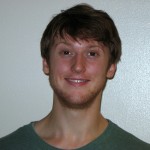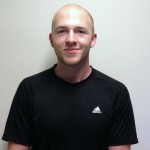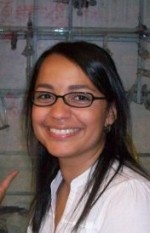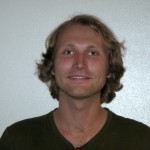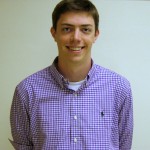Faculty Advisors: Cristina Marchetti & Lisa Manning
I work toward understanding the connections between the large-scale collective states available to a given dense tissue and the mechanical properties of individual cells within the tissue. To that end, we consider cells as polygons which tile the space available to them in a so-called “vertex model”. This model allows us to capture the influence of acto-myosin contractility, cortical tension of the cytoskeletal network, and adhesion between cells. In addition, cells constitute active matter and a simple form of crawling is included in the model. Recent work has demonstrated a liquid-solid transition in these tissues controlled by a mechanical “shape-index” parameter. This motivates us to explore the dynamics of finite and reproducible tissue patterns for different points in this phase space. Simulations are performed in a “wound-healing” geometry to explore which influences such as additional line tensions and outward crawling forces at the boundaries are required to reproduce experimental results.
On a related front, we consider a set of equations proposed to describe the hydrodynamic modes of these tissues. The cellular “shape-index” may be considered as a preferred aspect ratio of cells, the influence of which is expected in a scalar anisotropy field. Cellular motility if captured by coupling this field to a vector polarization field. Further exploration has revealed a direct analytical connection to the cellular shape energies. Analysis using linear stability techniques and direct simulation is revealing the existence of a flocked state, achieved by tuning the shape-index. This constitutes a density-independent flocking transition.
Faculty Advisor: Kate Lewis
My research centers on the transcription factors Hmx2 and Hmx3, which play a role in neurotransmitter phenotype specification in the zebrafish spinal cord. My work involves confirming putative interactions between Hmx2/3 and other proteins in order to elucidate the ways their transcriptional activity is regulated. For proteins that are confirmed as binding partners of Hmx2/3, mutations will be made in their respective genes so that the resulting phenotype can be analyzed. Finding genes that are necessary to specify certain aspects of neuronal development and understanding spinal cord development in general are fundamental steps towards finding ways to repair central nervous system damage.
Theresa Hendrick
Chemical Engineering
Faculty Advisor: Dacheng Ren
The goal of my research is to understand the underlying viscoelastic and rheological mechanisms in cell-matrix interfacial interactions in a dynamic environment. The hope is to be able to change 3-dimensional dynamical environments to control cell differentiation. The amphiphilic triblock A-B-A copolymer Pluronic (polyethylene oxide – polypropylene oxide – polyethylene oxide) is used as a 3-dimensional copolymeric matrix with tunable mechanical properties. These properties can be tuned by adjusting polymer concentration and the A/B ratio or molecular weight. Pluronics have been used in biomedical applications that utilized their thermoreversible gelation/micellization properties. This is entropically driven as the hydrophobic PPO associate to form the core of the micelles while the hydrophilic PEO forms the corona. It is expected that the inclusion of particulates such as polystyrene microbeads and cells will affect the rheological and mechanical properties of the resulting gel via micellization inhibition. From this, we hope to develop protocols for inducing mechanical stimulus/cues to modulate mechanical properties (e.g. viscosity, modulus, shear and normal stress) to control differentiation.
Nicholas Kelley
Chemical Engineering 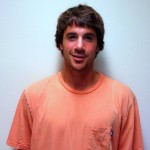
Faculty Advisor: Dacheng Ren
My research is focused on the engineering of novel bacterial co-culture systems using 3D bioprinting techniques. Currently, studies involving multiple bacteria are largely confined to two dimensions. By incorporating the cutting-edge technologies of stereolithography bioprinting (S-BP) and femtosecond lasers I will be able to create innovative 3D hydrogel co-culture systems. These are advantageous over traditional 2D systems since they will allow for spatial control of bacterial strains in all three dimensions, micron scale resolution and the ability to fine-tune the physical and chemical characteristics of the hydrogel scaffold. Therefore, my co-culture systems will be used to better understand the impact of geometry in biofilm formation and complex bacterial community/competition dynamics.
Faculty Advisors: Karin Ruhlandt, Jon Zubieta & Mathew Maye.
My research utilizes bisphosphonates, a chemical entity used in common drugs to treat bone diseases, in conjunction with calcium to obtain biocompatible and bioactive metal organic frameworks (MOFs) that could be used as bone cement additives. These materials are expected to be mechanically strong, light-weight, and flexible. For these properties to be achieved we must understand the fundamental chemistry behind the materials and their design. There are effective drug treatments for bone degrading diseases and many materials for bone implants; however, the materials used for these implants lack the mechanical properties needed for the application. Recent studies have led to the interest of composite and hybrid biomaterials as materials for bone substitutes and preliminary studies have shown the use of scaffolds enhances cell growth. We want to further study these findings by effectively designing and synthesizing materials that enhance bone cell growth by incorporating bisphosphonate moieties in the material.
Faculty Advisor: Cristina Marchetti
My research focuses on the physics of soft active matter, a relatively new branch of physics that seeks to describe groups of particles that move themselves via a variety of motility mechanisms. Myxobacteria, a common soil-dwelling bacterium, is an example of a system displaying group dynamics that may be described through an active matter model. In collaboration with the Welch Lab at Syracuse University and the Shaevitz Lab at Princeton University, I compare minimal active matter models to experimental results in an effort to understand how the actions of single M. xanthus cells may lead to social organization on much larger scales.
Faculty Advisor:

